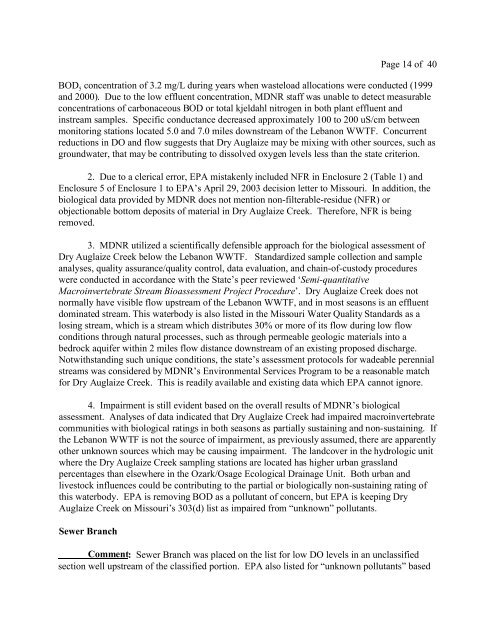responsiveness summary to public comments - US Environmental ...
responsiveness summary to public comments - US Environmental ...
responsiveness summary to public comments - US Environmental ...
You also want an ePaper? Increase the reach of your titles
YUMPU automatically turns print PDFs into web optimized ePapers that Google loves.
Page 14 of 40<br />
BOD 5 concentration of 3.2 mg/L during years when wasteload allocations were conducted (1999<br />
and 2000). Due <strong>to</strong> the low effluent concentration, MDNR staff was unable <strong>to</strong> detect measurable<br />
concentrations of carbonaceous BOD or <strong>to</strong>tal kjeldahl nitrogen in both plant effluent and<br />
instream samples. Specific conductance decreased approximately 100 <strong>to</strong> 200 uS/cm between<br />
moni<strong>to</strong>ring stations located 5.0 and 7.0 miles downstream of the Lebanon WWTF. Concurrent<br />
reductions in DO and flow suggests that Dry Auglaize may be mixing with other sources, such as<br />
groundwater, that may be contributing <strong>to</strong> dissolved oxygen levels less than the state criterion.<br />
2. Due <strong>to</strong> a clerical error, EPA mistakenly included NFR in Enclosure 2 (Table 1) and<br />
Enclosure 5 of Enclosure 1 <strong>to</strong> EPA’s April 29, 2003 decision letter <strong>to</strong> Missouri. In addition, the<br />
biological data provided by MDNR does not mention non-filterable-residue (NFR) or<br />
objectionable bot<strong>to</strong>m deposits of material in Dry Auglaize Creek. Therefore, NFR is being<br />
removed.<br />
3. MDNR utilized a scientifically defensible approach for the biological assessment of<br />
Dry Auglaize Creek below the Lebanon WWTF. Standardized sample collection and sample<br />
analyses, quality assurance/quality control, data evaluation, and chain-of-cus<strong>to</strong>dy procedures<br />
were conducted in accordance with the State’s peer reviewed ‘Semi-quantitative<br />
Macroinvertebrate Stream Bioassessment Project Procedure’. Dry Auglaize Creek does not<br />
normally have visible flow upstream of the Lebanon WWTF, and in most seasons is an effluent<br />
dominated stream. This waterbody is also listed in the Missouri Water Quality Standards as a<br />
losing stream, which is a stream which distributes 30% or more of its flow during low flow<br />
conditions through natural processes, such as through permeable geologic materials in<strong>to</strong> a<br />
bedrock aquifer within 2 miles flow distance downstream of an existing proposed discharge.<br />
Notwithstanding such unique conditions, the state’s assessment pro<strong>to</strong>cols for wadeable perennial<br />
streams was considered by MDNR’s <strong>Environmental</strong> Services Program <strong>to</strong> be a reasonable match<br />
for Dry Auglaize Creek. This is readily available and existing data which EPA cannot ignore.<br />
4. Impairment is still evident based on the overall results of MDNR’s biological<br />
assessment. Analyses of data indicated that Dry Auglaize Creek had impaired macroinvertebrate<br />
communities with biological ratings in both seasons as partially sustaining and non-sustaining. If<br />
the Lebanon WWTF is not the source of impairment, as previously assumed, there are apparently<br />
other unknown sources which may be causing impairment. The landcover in the hydrologic unit<br />
where the Dry Auglaize Creek sampling stations are located has higher urban grassland<br />
percentages than elsewhere in the Ozark/Osage Ecological Drainage Unit. Both urban and<br />
lives<strong>to</strong>ck influences could be contributing <strong>to</strong> the partial or biologically non-sustaining rating of<br />
this waterbody. EPA is removing BOD as a pollutant of concern, but EPA is keeping Dry<br />
Auglaize Creek on Missouri’s 303(d) list as impaired from “unknown” pollutants.<br />
Sewer Branch<br />
Comment: Sewer Branch was placed on the list for low DO levels in an unclassified<br />
section well upstream of the classified portion. EPA also listed for “unknown pollutants” based

















